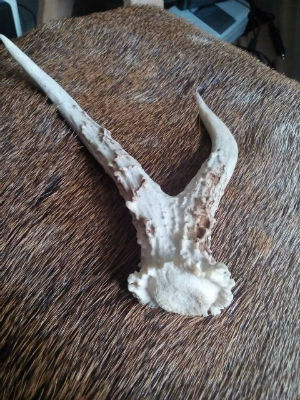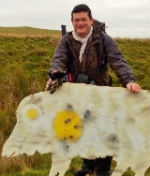Dr Simon Lee looks at the post Roe rut lull and the onset of winter.

I’ve just been out on our largest permission, about 1200 acres of field and wood in Hampshire. Everything’s changed.
The wheat has been cropped, baled, and removed leaving the field mice with a huge bonanza of dropped grain. What was a sea of tall golden heads that swayed in the slightest breeze top reveal heads and shoulders has been replaced by an ugly, bristly stubble.
How did this happen so quickly and what’s that nip in the air all of a sudden?
The wonders of mechanised agriculture have, in three short days, changed the entire face of our area completely.
It doesn’t seem a few short weeks since the frenzy of the roe rut, a few squeaks from the concealed Buttolo [other calls are available!] would have bucks exploding from the hedgerow to investigate, so where are they all?
Our adjoining woods are still thick with foliage and undergrowth, but edges near hedges do reveal tracks of deer, fleeting slots in the mud at crossing points, never standing, always slightly splayed as if running for the last bus from shelter to shelter.
So what is this feeling that drives the post rut roe behaviour? As usual, it’s all down to hormones.
 Let’s rewind to the chaos of summer, the long days, late sunsets and warmer weather, I try as best I can from one species to another, to put myself into the psyche of the deer, a buck at the height of his desperate urge to mate, the closest I could dredge up from my memory tank was at the school discos of the mid-eighties, a difficult time at best for any adolescent, these events produced a string of irrational behavioural urges I still cannot fully explain.
Let’s rewind to the chaos of summer, the long days, late sunsets and warmer weather, I try as best I can from one species to another, to put myself into the psyche of the deer, a buck at the height of his desperate urge to mate, the closest I could dredge up from my memory tank was at the school discos of the mid-eighties, a difficult time at best for any adolescent, these events produced a string of irrational behavioural urges I still cannot fully explain.
And I was not alone! Outrageous outfits, posturing, preening, peacock strutting, the courtship displays of the young still make me cringe decades later. . .
The urge to procreate is one of the strongest in the animal kingdom, and we, as arguably advanced apes, are equally subject to the rollercoaster effects of the endocrine system that governs our hormones.
Consider the yearling roebuck and his equivalent drives, his urge to find a mate will move him to invade territory, defend himself against elder males, and take enormous risks to pass on his genes. The mere squeak of a ‘female in oestrus’ call will have him bravely investigating where otherwise he wouldn’t. Life, it seems, is a gamble.
Perhaps our buck succeeded, bred with a female, and has slunk back to the safety of the woods to recover and repair damage accrued from fighting his cause. I’ve seen bucks fight over territory and females and it can get very nasty indeed, antlers are pointed for a reason and more often than not, I’ve taken a few one-eyed warriors on their blind side after the rut has run its course.
What of the does? Once the pandemonium of the rut and it’s well documented antics has taken place, what next?
Science tells us the phenomenon of ‘embryonic diapause’, or to the layman, a pregnant roe doe not immediately starting her pregnancy, is largely down to body weight as its prime factor.
In short, pregnancy won’t start properly until she has put on enough weight to sustain her and the embryo though the winter.
Other changes are taking place across the genders, the ‘pelage’ or fur starts to change, the russet coat of summer is soon outgrown by a thicker, darker fur that serves not only as camouflage but also to preserve energy reserves, energy that will be needed for colder days ahead as fatty deposits between fur and muscle.
Having served their purpose the antlers will be off next, all the energy that went into producing a set of fighting tines is now switched to building fat reserves.
From a biological viewpoint, ‘aseptic bone necrosis’ takes place, a layer of cells at the pedicle simply dies off and creates a fracture line at which the antler snaps away.
How much of this is felt by the deer is down to conjecture but I have witnessed the lopsided discomfort of fallow bucks who have lost one antler, flailing about trying to encourage the other one to fall off.
The dropped antler is used as a source of minerals like calcium to smaller mammals, should you find a dropped antler you may like to leave it where it is, something will find it useful!
It would however be hard to resist the novelty of a huge palmated fallow antler if you were lucky enough to stumble across one, I gather our cousins ‘across the pond’ have techniques like leaving a netting mesh of bungee cord in key places to trap for the antler, personally I can’t bring myself to leave entanglement hazards about the place.
So now the grouping starts, females and males coming together into a loose pack system, with perhaps a matriarch as a leader and a remaining attendant buck for security, from a species point of view a herd can support itself far better than an individual, spot one roe at the moment and there may be more not far away.
Between now and Halloween, we, as stalkers are legally mopping up any male roe on our cull plan, with their antlers off gender identification is paramount, the diagnostic anal tush can be the best way to get the right animal.
As for the other species we enjoy, muntjac are on offer all year round, but are better left until the undergrowth has died back a bit to reveal the ground to 18” area they inhabit.
Next up for fallow is their rut, October and November we will hear the sounds of grunts and groans of master bucks establishing their territory and advertising themselves, by then the woods will be a little more accessible, making a stealthy approach easier.
But inevitably, as they say in the North, Winter is coming, so plans for feed piles and mineral licks should be considered and high seat positions reviewed, what was a great spot in the summer may be all but useless in the winter having lost cover and foliage.
Another factor in terms of seasonal change is temperature, and the use of thermal imagers, having reviewed a tiny unit earlier last year and looked into how this miracle of technology actually works, it’s a question of differential heat signatures, the cooler the surrounding area the more a mammal will stand out for identification. So a drop in general temperature in winter will produce a clearer image then a hot summer’s day.
The use of the thermal imager within the sphere of deer stalking is hotly (excuse the pun) debated across various forums, but for a contractor with a set cull plan to fulfil it can really help save time.
Like all technology, the use of thermal has no reverse gear and soon what was new-fangled becomes standard, and before long, established practice.
So as we slide towards winter, I wish you luck with your midseason stalking, however you choose to do it. Wrap up, tread lightly, and shoot straight!
 To read an article from Simon in which he discusses thermal imagers follow this link: thermal-imaging-review
To read an article from Simon in which he discusses thermal imagers follow this link: thermal-imaging-review



















